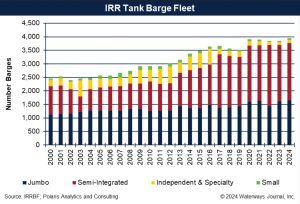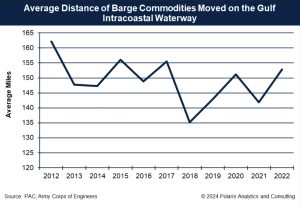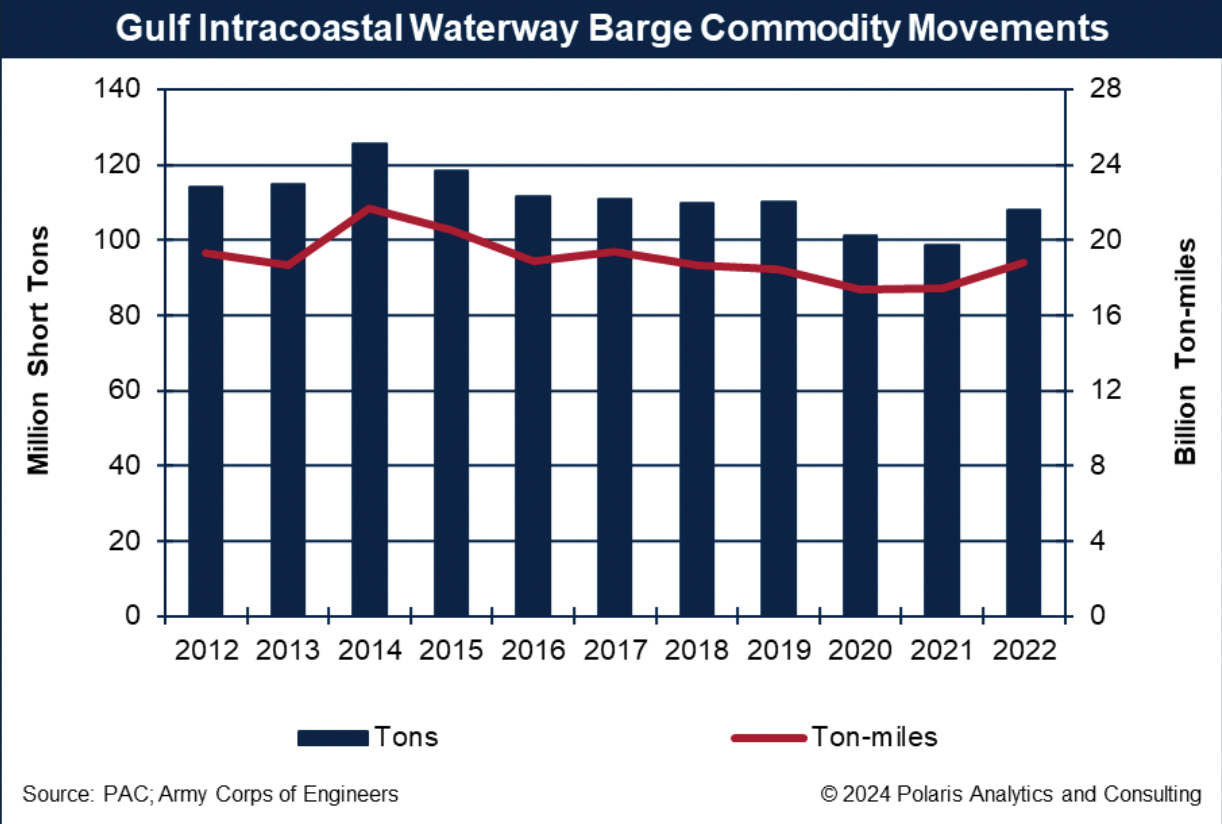
Stretching 1,200 miles between Brownsville, Texas, and St. Marks, Fla., the Gulf Intracoastal Waterway (GIWW) connects many cities, including Houston, New Orleans and Mobile, Ala., and the Mississippi River and its connecting tributaries. The GIWW most adroitly serves the expansive energy and chemical complex of the United States with the fuel and feedstocks that are the building blocks that run the U.S. economy.
The volume of commodities moved by barge along the GIWW totaled 108.1 million short tons in 2022. That was an increase of 10 percent from the pandemic low during 2021. Movements have averaged 111.5 million over the past decade. Commodity ton-miles moved from, to or within the GIWW (moving one ton of cargo one mile) totaled 18.8 billion in 2022, averaging 19 billion over the past decade and 8 percent above the pandemic low in 2020, as shown in the following chart.
Energizing The Economy
Not surprisingly, the commodity mix moved along the GIWW is energy focused, with crude petroleum, fuel oils, naphtha and solvents and gasoline representing about one-half of the tons and ton-miles.
One interesting commodity that appears on the GIWW is tallow (animal oils). In 2018, 14,333 short tons of tallow was moved on the GIWW. That number swelled to 41,582 tons in 2019, then dropped below 10,000 tons in 2020 and 2021. During 2022, tallow movements surged to 77,588 short tons, the highest level since at least 2012. As of now, tallow has been a “through move” with an easterly direction.
With renewable diesel using various feedstocks, such as tallow, the movements could include imported volumes loaded onto a barge, or barges loaded on other systems and transiting the GIWW en route to another waterway system. Despite the growth, tallow movements are a relatively small portion of all the commodities or products moved on the GIWW. Nonetheless, tallow will be a commodity to monitor and an example of how the GIWW serves all sectors.
Short Moves, Big Impacts
Many of the commodities moved on the GIWW travel relatively short distances. The average distance commodities moved on the GIWW in 2022 was 153 miles, 11 miles above the average distance during 2021 and about 3 miles above the average of the past decade as shown in the accompanying chart. The distance moved by commodity varies depending on the direction and type of movements (e.g., out of, into, within or through the GIWW).
The longest average distance involved commodities or products used in the construction of buildings or infrastructure, including pipe and tubes. Liquid cargoes, such as petroleum products or chemicals, tend to average less than 400 miles. There are also movements of chemical commodities or products that exceed 1,000 miles from GIWW origin to the upper reaches of the Mississippi, Ohio or Illinois Rivers.
Aging Tank Barges
With liquid products comprising most of the commodities moved on the GIWW, tank barges are key assets plying the waterway. As referenced in the Horizons column in the WJ on June 14 (U.S. Inland Barge Fleet Aging Despite Getting Bigger), the tank fleet totaled a record 3,947 barges during 2023. Many of the tank barge configurations on the GIWW are dedicated two- or six-pack (or barges) tows.
The tank fleet largely consists of jumbo (10,001 to 20,000 barrels) and semi-integrated (20,001 or more barrels) barges. The semi-integrated fleet has expanded the most since 2013, when it became the largest portion of the fleet as shown in the following chart.
But the tank fleet is aging. From 2013 to 2021, the tank fleet age averaged about 15 years old. In 2022, the average age increased to 15.4 years, and it rose again to 17.7 years in 2023. Prior to 2010, the fleet averaged about 20 years. Building new barges has become more expensive with higher steel and labor costs, and now higher finance costs. Replacing the fleet, let alone expanding it, will be slow, thus the age of the fleet is maturing.
Keeping GIWW In Focus
Shippers and the towing industry alike strive to uphold the value and importance of the GIWW. Through the efforts of the Gulf Intracoastal Canal Association, U.S. Army Corps of Engineers and U.S. Coast Guard, the GIWW remains a vital, safe and operational lifeline for commerce, trade and prosperity. The impact of the GIWW reverberates across state lines, supporting jobs, economic growth and the movement of essential goods. While navigating the waters of progress, be sure to recognize the vital role played by this remarkable waterway.




